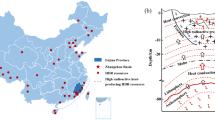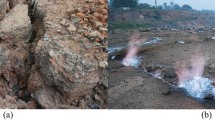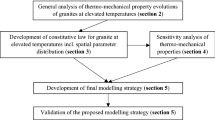Abstract
High temperature is an important factor affecting the mechanical properties and crack propagation behavior of granite. In this study, the mechanical properties and thermal damage mechanism of granite after high temperature are studied experimentally. Subsequently, based on the content and distribution of granite minerals, combined with computed tomography (CT) technique and grain-based model (GBM) modeling method, a novel discrete element numerical model considering real mineral distribution is introduced, and the rationality of the method is verified by experiments. On this basis, the mechanical behavior, crack propagation behavior and failure mode of granite after high temperature are studied. The results show that 450 °C is the thermal damage threshold of granite in this study. When T ≤ 450 °C, the development of thermally-induced microcracks is not significant, the P-wave velocity of granite decreases slightly, and the change of mechanical properties is not obvious. When T > 450 °C, the thermally-induced microcrack propagates rapidly, the fracture network and fracture zone are formed locally in the specimen, and the P-wave velocity and mechanical properties of granite deteriorate significantly. The simulation results show that the number of thermally-induced microcracks in granite specimens is positively correlated with temperature, and the tensile cracks are mainly at the mineral boundary, and the thermal stress concentration between mineral particles is the main cause of thermally-induced microcracks. After temperature treatment, there are mainly tensile cracks in granite specimens under uniaxial compression, and the orientation of tensile cracks tends to be isotropic with the increase of temperature. When T < 600 °C, the crack distribution and failure mode of granite specimens under uniaxial compression are consistent with those at room temperature. When T ≥ 600 °C, thermally-induced microcracks begin to dominate the uniaxial compression failure process, and granite specimens begin to show ductile failure characteristics, and the brittle-plastic transition was observed between 600 °C and 750 °C.
Highlights
-
A novel thermo-mechanical grain-based model considering the distribution of real granite minerals is proposed.
-
450°C is the threshold temperature for thermal damage of granite in this study. When T≥600 °C, thermally-induced microcracks dominate the failure mode of granite, and brittle-plastic transition is observed between 600 °C and 750 °C.
-
The orientation distribution of tensile crack caused by axial load tends to be isotropic with the increase of temperature.

























Similar content being viewed by others
Data availability
All data is provided as tables and fgures in the manuscript.
References
Akdag S, Karakus M, Taheri A et al (2018) Effects of thermal damage on strain burst mechanism for brittle rocks under true-triaxial loading conditions. Rock Mech Rock Eng 51(6):1657–1682
Cai M (2010) Practical estimates of tensile strength and the Hoek-Brown strength parameter mi of brittle rocks. Rock Mech Rock Eng 43:167–184
Chen P (2017) Effects of microparameters on macroparameters of flat-jointed bonded-particle materials and suggestions on trial-and-error method. Geotech Geol Eng 35(2):663–677
Chen Y, Ni J, Shao W et al (2012) Experimental study on the influence of temperature on the mechanical properties of granite under uniaxial compression and fatigue loading. Int J Rock Mech Min Sci 56:62–66
Du S, Liu H, Zhi H et al (2004) Testing study on mechanical properties of post-high-temperature granite. Chin J Rock Mech Eng 23(14):2359–2359 ((In Chinese))
Duan Y, Li X, Zheng B, He J, Hao J (2019) Cracking evolution and failure characteristics of Longmaxi shale under uniaxial compression using real-time computed tomography scanning. Rock Mech Rock Eng 52:3003–3015
Fan L, Gao J, Wu Z et al (2018) An investigation of thermal effects on micro-properties of granite by X-ray CT technique. Appl Therm Eng 140:505–519
Fan L, Gao J, Du X (2020) Thermal cycling effects on micro-property variation of granite by a spatial micro-observation. Rock Mech Rock Eng 53(6):2921–2928
Fan L, Fan Y, Xi Y et al (2022) Spatial failure mode analysis of frozen sandstone under uniaxial compression based on CT technology. Rock Mech Rock Eng 55:4123–4138
Feng G, Wang X, Kang Y, Zhang Z (2020a) Effect of thermal cycling-dependent cracks on physical and mechanical properties of granite for enhanced geothermal system. Int J Rock Mech Min Sci 134:104476
Feng G, Wang X, Wang M, Kang Y (2020b) Experimental investigation of thermal cycling on fracture characteristics of granite in a geothermal-energy reservoir. Eng Fract Mech 235:107180
Fredrich J, Wong T (1986) Micromechanics of thermally induced cracking in three crustal rocks. J Geophys Res Solid Earth 91(B12):12743–12764
Gao J, Xi Y, Fan L et al (2021) Real-time visual analysis of the microcracking behavior of thermally damaged granite under uniaxial loading. Rock Mech Rock Eng 54(12):6549–6564
Gautam P, Verma A, Jha M et al (2018) Effect of high temperature on physical and mechanical properties of Jalore granite. J Appl Geophy 159:460–474
Griffiths L, Lengline O, Heap M et al (2018) Thermal cracking in westerly granite monitored using direct wave velocity, coda wave interferometry, and acoustic emissions. J Geophys Res Solid Earth 123:2246–2261
Guo P, Bu M, He M, Wang Y (2020a) Experimental investigation on thermal conductivity of clay-bearing sandstone subjected to different treatment processes: drying, wetting and drying II. Geothermics 88:101909
Guo P, Bu M, Li Q, He M (2020b) Research progress of accurate measurement and characterization model of effective thermal conductivity of rock. Chin J Rock Mech Eng 39(10):1983–2013
Guo P, Zhang P, Bu M et al (2023) Microcracking behavior and damage mechanism of granite subjected to high temperature based on CT-GBM numerical simulation Computers and Geotechnics 159105385. https://doi.org/10.1016/j.compgeo.2023.105385
Hao J, Qiao L, Li Q (2022) Study on cross-scale pores fractal characteristics of granite after high temperature and rock failure precursor under uniaxial compression. Powder Technol 401:117330
Homand-Etienne F, Houpert R (1989) Thermally induced microcracking in granites: characterization and analysis. Int J Rock Mech Min Sci Geomech Abstr 26(2):125–134
Horai K (1971) Thermal conductivity of rock forming minerals. J Geophys Res 76(5):1278–1308
Hu X, Xie N, Zhu Q et al (2020) Modeling damage evolution in heterogeneous granite using digital image-based grain-based model. Rock Mech Rock Eng 53:4925–4945
Isaka B, Gamage R, Rathnaweera T et al (2018) An influence of thermally-induced micro-cracking under cooling treatments: mechanical characteristics of Australian granite. Energies 11(6):1338
Isaka A, Ranjith PG, Rathnaweera T et al (2019) Quantification of thermally-induced microcracks in granite using X-ray CT imaging and analysis. Geothermics 81:152–167
Jansen D, Carlson S, Young R et al (1993) Ultrasonic imaging and acoustic emission monitoring of thermally induced microcracks in Lac du Bonnet granite. J Geophys Res 98(B12):22231–22243
Jin P, Hu Y, Shao J et al (2019a) Influence of different thermal cycling treatments on the physical, mechanical and transport properties of granite. Geothermics 78:118–128
Jin P, Hu Y, Shao J, Zhao G, Zhu X, Li C (2019b) Influence of different thermal cycling treatments on the physical, mechanical and transport properties of granite. Geothermics 78:118–128
Kang F, Jia T, Li Y et al (2021) Experimental study on the physical and mechanical variations of hot granite under different cooling treatments. Renew Energy 179:1316–1328
Kim K, Kemeny J, Nickerson M (2013) Effect of rapid thermal cooling on mechanical rock properties. Rock Mech Rock Eng 47(6):2005–2019
Kumari W, Ranjith P, Perera M et al (2017) Temperature-dependent mechanical behaviour of Australian Strathbogie granite with different cooling treatments. Eng Geol 229:31–44
Li Z, Wong L, Teh C (2020) Influence of thermal and mechanical loading on development of microcracks in granite. Rock Mech Rock Eng. https://doi.org/10.1007/s00603-019-02030-0
Li Q, Li X, Yin T (2021) Factors affecting pore structure of granite under cyclic heating and cooling: a nuclear magnetic resonance investigation. Geothermics 96(4):102198
Li B, Liang Q, Zhou Y et al (2022a) Research on crack propagation law of granite based on CT-GBM reconstruction method. Chin J Rock Mech Eng 41(06):1114–1125 ((in Chinese))
Li M, Wu Z, Weng L et al (2022b) Quantitative relationships between the mineral composition and macro mechanical behaviors of granite under different temperatures: insights from mesostructure-based DEM investigations. Comput Geotech 148:104838
Liang X, Tang S, Tang C, Hu L, Chen F (2023) Influence of water on the mechanical properties and failure behaviors of sandstone under triaxial compression. Rock Mech Rock Eng 56:1131–1162
Liu S, Xu J (2015) An experimental study on the physico-mechanical properties of two post-high-temperature rocks. Eng Geol 185:63–70
Meng F, Song J, Wong L et al (2021) Characterization of roughness and shear behavior of thermally treated granite fractures. Eng Geol 293:106287
Pan X, Zhou X (2022) Damage analysis of sandstone during the creep stage after high-temperature heat treatment based on NMR technology. Rock Mech Rock Eng. https://doi.org/10.1007/s00603-022-03048-7
Peng J, Wong L, Teh C et al (2017) Modeling micro-cracking behavior of Bukit Timah granite using grain-based model. Rock Mech Rock Eng 51(1):135–154
Peng J, Rong G, Yao M et al (2018) Acoustic emission characteristics of a fine-grained marble with different thermal damages and specimen sizes. Bull Eng Geol Environ 78:4479–4491
Qin Y, Tian H, Xu N et al (2019) Physical and mechanical properties of granite after high-temperature treatment. Rock Mech Rock Eng 53(1):305–322
Sha S, Rong G, Chen Z et al (2020) Experimental evaluation of physical and mechanical properties of geothermal reservoir rock after different cooling treatments. Rock Mech Rock Eng 53(11):4967–4991
Shao S, Wasantha P, Ranjith P et al (2014) Effect of cooling rate on the mechanical behavior of heated Strathbogie granite with different grain sizes. Int J Rock Mech Min Sci 70:381–387
Shao S, Ranjith P, Wasantha L et al (2015) Experimental and numerical studies on the mechanical behaviour of Australian Strathbogie granite at high temperatures: an application to geothermal energy. Geothermics 54:96–108
Sun Q, Zhang W, Xue L et al (2015) Thermal damage pattern and thresholds of granite. Environ Earth Sci 74(3):2341–2349
Sun Q, Geng J, Zhao F (2020) Experiment study of physical and mechanical properties of sandstone after variable thermal cycles. Bull Eng Geol Environ. https://doi.org/10.1007/s10064-020-01779-x
Sun W, Wu S, Xu X (2021) Mechanical behaviour of Lac du Bonnet granite after high-temperature treatment using bonded-particle model and moment tensor. Comput Geotech 135:104132
Tang S, Li J, Ding S, Zhang L (2022) The influence of water-stress loading sequences on the creep behavior of granite. Bull Eng Geol Env 81:482
Tian W, Yang S, Huang Y et al (2020a) Mechanical behavior of granite with different grain sizes after high-temperature treatment by particle flow simulation. Rock Mech Rock Eng 53:1791–1807
Tian W, Yang S, Wang J et al (2020b) Numerical simulation of permeability evolution in granite after thermal treatment. Comput Geotech 126:103705
Wang Y, Hou Z, Hu Y (2018a) In situ X-ray micro-CT for investigation of damage evolution in black shale under uniaxial compression. Environ Earth Sci 77(20):717
Wang Y, Li C, Hao J, Zhou R (2018b) X-ray micro-tomography for investigation of meso-structural changes and crack evolutionin Longmaxi formation shale during compressive deformation. J Petrol Sci Eng 164:278–288
Wang F, Konieteky H, Herbst M et al (2022a) Mechanical responses of grain-based models considering different crystallographic spatial distributions to simulate heterogeneous rocks under loading. Int J Rock Mech Min Sci 151:105036
Wang H, Li H, Tang L, Ren X, Meng Q, Zhu C (2022b) Fracture of two three-dimensional parallel internal cracks in brittle solid under ultrasonic fracturing. J Rock Mech Geotech Eng 14(3):757–769
Wanne T, Young R (2008) Bonded-particle modeling of thermally fractured granite. Int J Rock Mech Min Sci 45(5):789–799
Wong L, Zhang Y, Wu Z (2020) Rock strengthening or weakening upon heating in the mild temperature range? Eng Geol 272:105619
Wu X, Huang Z, Song H et al (2019) Variations of physical and mechanical properties of heated granite after rapid cooling with liquid nitrogen. Rock Mech Rock Eng. https://doi.org/10.1007/s00603-018-1727-3
Xiao Y, Lu J, Wang C, Deng J (2016) Experimental study of high-temperature fracture propagation in anthracite and destruction of mudstone from coalfield using high-resolution microfocus X-ray computed tomography. Rock Mech Rock Eng 49(9):3723–3734
Xu X, Karakus M (2018) A coupled thermo-mechanical damage model for granite. Int J Rock Mech Min Sci 103:195–204
Xu L, Gong F, Liu Z (2021) Experiments on rockburst proneness of pre-heated granite at different temperatures: insights from energy storage, dissipation and surplus. J Rock Mech Geotech Eng. https://doi.org/10.1016/j.jrmge.2021.08.004
Yang S, Ranjith P, Jing H et al (2017) An experimental investigation on thermal damage and failure mechanical behavior of granite after exposure to different high temperature treatments. Geothermics 65:180–197
Yin T, Zhuang D, Li M, Li X (2022) Numerical simulation study on the thermal stress evolution and thermal cracking law of granite under heat conduction. Comput Geotech 148:104813
Zhang X, Wong L (2011) Cracking processes in rock-like material containing a single flaw under uniaxial compression: a numerical study based on parallel bonded-particle model approach. Rock Mech Rock Eng 45:711–737
Zhang Z, Gao F, Gao Y et al (2016) Fractal structure and model of pore size distribution of granite under high temperatures. Chin J Rock Mech Eng 35(12):2426–2438 ((in Chinese))
Zhang F, Zhao J, Hu D et al (2017) Laboratory investigation on physical and mechanical properties of granite after heating and water-cooling treatment. Rock Mech Rock Eng 51(3):677–694
Zhang Y, Wong L, Chan K (2019) An extended grain-based model accounting for microstructures in rock deformation. J Geophys Res 124(1):125–148
Zhao Z, Liu Z, Pu H et al (2018) Effect of thermal treatment on Brazilian tensile strength of granites with different grain size distributions. Rock Mech Rock Eng 51:1293–1303
Zhao Z, Dou Z, Xu H et al (2019) Shear behavior of Beishan granite fractures after thermal treatment. Eng Fract Mech 213:223–240
Zhu H, Yan Z, Deng T et al (2006) Testing study on mechanical properties of tuff, granite and breccia after high temperatures. Chin J Rock Mech Eng 25(10):1945–1950 ((in Chinese))
Zhu Z, Kempka T, Ranjith P et al (2021a) Changes in thermomechanical properties due to air and water cooling of hot dry granite rocks under unconfined compression. Renewable Energy 170:562–573
Zhu Z, Tian H, Mei G et al (2021b) Experimental investigation on mechanical behaviors of Nanan granite after thermal treatment under conventional triaxial compression. Environ Earth Sci https://doi.org/10.1007/s12665-020-09326-3.
Acknowledgements
Funding for this work was provided by Natural Science Foundation of China (41941018) and supported by Natural Science Foundation of China (42241145) and supported by the Fundamental Research Funds for the Central Universities (2021JCCXLJ05) and supported by China Postdoctoral Science Foundation (2021M701541) and Science and Technology Innovation Project of Chinese Institute of Coal Science (2021-KXYJ-001).
Author information
Authors and Affiliations
Corresponding author
Ethics declarations
Conflict of Interest
The authors declare that they have no known competing financial interests or personal relationships that could have appeared to influence the work reported in this paper.
Additional information
Publisher's Note
Springer Nature remains neutral with regard to jurisdictional claims in published maps and institutional affiliations.
Rights and permissions
Springer Nature or its licensor (e.g. a society or other partner) holds exclusive rights to this article under a publishing agreement with the author(s) or other rightsholder(s); author self-archiving of the accepted manuscript version of this article is solely governed by the terms of such publishing agreement and applicable law.
About this article
Cite this article
Guo, P., Bu, M., Zhang, P. et al. Mechanical Properties and Crack Propagation Behavior of Granite After High Temperature Treatment Based on a Thermo-Mechanical Grain-Based Model. Rock Mech Rock Eng 56, 6411–6435 (2023). https://doi.org/10.1007/s00603-023-03408-x
Received:
Accepted:
Published:
Issue Date:
DOI: https://doi.org/10.1007/s00603-023-03408-x




